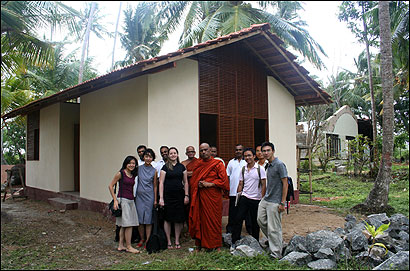 |
 |
 |
|
The Boston Globe Safe(r) in Sri Lanka: An MIT-Harvard team designs and builds a prototype house to withstand future tsunamis.
AFTER LAST DECEMBER'S TSUNAMI RIPPED into the South Asian island nation of Sri Lanka, a team of Massachusetts Institute of Technology and Harvard Design School architects and planners came up with a design for a new kind of house to better withstand a future storm. (Globe Magazine, July 24). The Tsunami Safe(r) House employs the same number of concrete blocks as a standard Sri Lankan home, but instead of using them to build walls, the team has arranged them into stout pillars that form a framework for wooden or bamboo walls. If a tidal wave roars through, the core of the house is more likely to survive. A London engineering firm verified that the design was up to five times stronger than conventional construction. But when members of the design team visited the site in Balapitiya, on the southwestern coast, where a prototype was being built last summer, they learned that local residents had a far more poetic way to explain the concept. As one Sri Lankan put it: "You open the door and tell the water: ‘Please enter this way.' " Translating an idea sketched out at Cambridge conference tables to real-life conditions 10,000 miles away did require some changes. For example, the initial plan called for houses to be built on raised platforms, so storm water could fl ow under them. But Sri Lankans were uncomfortable with that idea, says Carlo Ratti, an MIT urban planning professor who helped form the group. "Houses on stilts are almost nonexistent in that part of Sri Lanka," says Ratti. "From a practical point of view, people were concerned about snakes and rubbish ending up under the platform. So, in the end, we eliminated it, as it does not undermine the main design concepts." And because shortages of building supplies in Sri Lanka have driven up prices, the house cost $3,500 to build – more than double the team's projection of $1,500. The MIT-based Prajnopaya Foundation and MIT's Buddhist chaplain, the Venerable Tenzin Priyadarshi, are working to raise money to build 1,000 Tsunami Safe(r) houses. A consortium of religious groups that Prajnopaya is also supporting has completed 200 traditionally designed homes and hopes to build 200 more in the coming year. "The progress has been satisfactory," Priyadarshi says, but back-to-back natural disasters – Hurricane Katrina and the earthquake in India and Pakistan – have made fund-raising a challenge. "There should be some way of not forgetting that people are still in need because of the tsunami," he says. Peter J. Howe is a Globe business reporter. Send e-mails to This e-mail address is being protected from spambots. You need JavaScript enabled to view it . |
